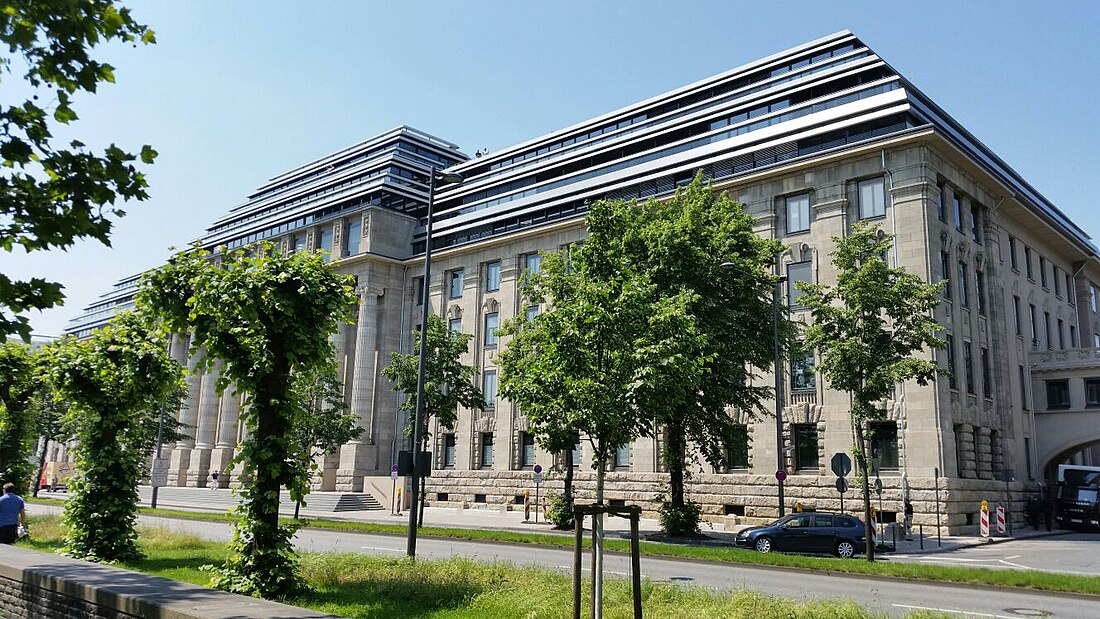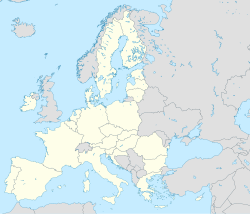European Union Aviation Safety Agency
European Union civil aviation authority From Wikipedia, the free encyclopedia
The European Union Aviation Safety Agency (EASA) is an agency of the European Commission with responsibility for civil aviation safety in the European Union. It carries out certification, regulation and standardisation and also performs investigation and monitoring.[2]: §4.3 It collects and analyses safety data, drafts and advises on safety legislation and co-ordinates with similar organisations in other parts of the world.[2]: §4.3
This article has multiple issues. Please help improve it or discuss these issues on the talk page. (Learn how and when to remove these messages)
|
The idea of a European-level aviation safety authority goes back to 1996, but the agency was legally established only in 2002; it began its work in 2003.[2]: §4.3
History
Summarize
Perspective
Based in Cologne, Germany, the agency was created on 15 July 2002 as the "European Aviation Safety Agency",[3] and reached full functionality in 2008,[citation needed] taking over functions of the Joint Aviation Authorities. It was renamed the "European Union Aviation Safety Agency" in 2018.[3] European Free Trade Association countries participate in the agency. The United Kingdom was a member until the end of the Brexit transition period on 31 December 2020.[4]
The responsibilities of the agency include the analysis and research of safety parameters, authorizing foreign operators, and advising the European Commission on the drafting of EU legislation. It also implements and monitors safety rules (including inspections in the member states), gives type certification of aircraft and components, and approves organisations involved in the design, manufacture and maintenance of aeronautical products.
As part of Single European Sky II (SES-II), an initiative to standardize and coordinate all air traffic control over the EU, the agency has been given additional tasks,[5] which were implemented before 2013.[6][7] Since 4 December 2012, EASA is able to certify functional airspace blocks if more than three parties are involved.[7]
The EU commission is proposing to further expand EASA mandate to act the European Performance Review Board, with a clear separation of National Supervisory Agencies and Air Navigation Service Providers[8]
In 2012, the European Court of Auditors (ECA) found that the agency did not have an agency-specific conflict of interest policy and procedures. EASA did not obtain or assess the declarations of interest for staff, management board, board of appeal and experts.[9] In its report, ECA declared that:
The worst performer among the four was the EASA, based in Cologne, which failed in all four areas that the report analyzed – on experts, staff, management board, and board of appeals.[10]
It was recommended that the organization adopt its own ethical standards because the then-existing condition exposed the agency to a substantial crisis of credibility as well as the incidence of favoritism and conflict of interest. For member-countries and other stakeholders, fairness is of paramount importance. This is because the European Union has been increasingly strengthening EASA's role, giving the agency independence. A discussion regarding the permission for the agency to impose financial penalties for safety violations is[when?] also underway.[11]
Responsibilities
Summarize
Perspective
EASA is responsible for new type certificates and other design-related airworthiness approvals for aircraft, engines, propellers and parts. EASA works with the EU member states' civil aviation authorities (CAAs) but has taken over many of their functions in the interest of aviation standardisation across the EU and in the non-EU member Turkey.[12] EASA is also responsible for assisting the European Commission in negotiating international harmonisation agreements with the "rest of the world" on behalf of the EU member states, and it concludes technical agreements at a working level directly with its counterparts around the world such as the US Federal Aviation Administration (FAA). EASA also sets policy for aeronautical repair stations (Part 145 organisations in Europe and the US, also known as Part 571 organisations in Canada) and issues repair station certificates for repair stations located outside the EU, which permit foreign repair stations to perform work that is acceptable to the EU on its aircraft). EASA has developed regulations for air operations, flight crew licensing and non-EU aircraft used in the EU, which applied since the required European legislation to expand the agency's remit entered into force. The legislation was published on 19 March 2008.[13]
EASA has had its scope enlarged, as part of the new delegation in 2018, to also cover UAVs. The first 2 regulations (EU DR 2019-945 & EU IR 947) for drones were effective by 30 December 2019 in order for them to also cover the UK (Brexit).[citation needed]
Annual safety review
The agency publishes an annual safety review[14] with statistics on European and worldwide civil aviation safety. Some information derives from the International Civil Aviation Organization and the NLR Air Transport Safety Institute.[15]
In June 2020, EASA banned Pakistan International Airlines from flying to Europe[16] after a fatal crash in May caused by pilot error. An investigation discovered that one third of pilot licenses in Pakistan are fraudulent.[17]
States subject to EASA services and oversight
Summarize
Perspective
As an EU agency, the EASA is not a membership organization. All states which are a member of the EU also take part in EASA's services and are subject to oversight by EASA. It is not possible to opt out of the arrangement without withdrawing from the EU.
Those European countries which are not members of the EU but members of EFTA, namely Liechtenstein, Norway, Switzerland, and Iceland, have been granted participation to the arrangement under Article 129 of the Basic Regulation (Regulation 2018/1139). These states are members of the management board, but do not have voting rights. While the legal basis is different for states which are members of the EU and those who are not, the EASA has the same power for all states who participate in the arrangement. [18]
There are also working relationships with other regional and international authorities.[19] For example, EASA cooperates with most of the EU's Eastern Partnership member states through EASA's Pan-European Partners (PANEP) initiative in which countries such as Armenia,[20] Azerbaijan,[21] Georgia,[22] Moldova[23] and Ukraine[24] co-operate on the implementation of EU aviation safety rules and comprehensive aviation agreements.
List of Current EASA Member-States
Source:[25]
 Austro Control
Austro Control Belgian Civil Aviation Authority
Belgian Civil Aviation Authority Civil Aviation Administration (Bulgaria)
Civil Aviation Administration (Bulgaria) Croatian Civil Aviation Agency
Croatian Civil Aviation Agency Department of Civil Aviation (Cyprus)
Department of Civil Aviation (Cyprus) Civil Aviation Authority of the Czech Republic
Civil Aviation Authority of the Czech Republic Danish Civil Aviation and Railway Authority
Danish Civil Aviation and Railway Authority Estonian Civil Aviation Administration
Estonian Civil Aviation Administration Finnish Transport and Communications Agency
Finnish Transport and Communications Agency Directorate General for Civil Aviation (France)
Directorate General for Civil Aviation (France) Federal Aviation Office
Federal Aviation Office Hellenic Civil Aviation Authority
Hellenic Civil Aviation Authority National Transport Authority (Hungary)
National Transport Authority (Hungary) Icelandic Transport Authority
Icelandic Transport Authority Irish Aviation Authority
Irish Aviation Authority National Agency for Civil Aviation
National Agency for Civil Aviation Latvian Civil Aviation Agency
Latvian Civil Aviation Agency Office of Civil Aviation of Liechtenstein
Office of Civil Aviation of Liechtenstein Public Transport Competence Agency
Public Transport Competence Agency Directorate of Civil Aviation of Luxembourg
Directorate of Civil Aviation of Luxembourg Civil Aviation Directorate of Malta
Civil Aviation Directorate of Malta Human Environment and Transport Inspectorate
Human Environment and Transport Inspectorate Civil Aviation Authority of Norway
Civil Aviation Authority of Norway Civil Aviation Authority
Civil Aviation Authority National Authority of Civil Aviation of Portugal
National Authority of Civil Aviation of Portugal Romanian Civil Aeronautical Authority
Romanian Civil Aeronautical Authority Civil Aviation Authority of the Slovak Republic
Civil Aviation Authority of the Slovak Republic Civil Aviation Authority of the Slovenian Republic
Civil Aviation Authority of the Slovenian Republic Spanish Aviation Safety and Security Agency
Spanish Aviation Safety and Security Agency Swedish Transport Agency
Swedish Transport Agency Federal Office for Civil Aviation
Federal Office for Civil Aviation
Former EASA Member-States
Prior to the UK's withdrawal from the EU, the UK Civil Aviation Authority was an EASA member-state.
Certification
Summarize
Perspective
On 28 September 2003, the agency took over responsibility for the airworthiness and environmental certification of all aeronautical products, parts, and appliances designed, manufactured, maintained or used by persons under the regulatory oversight of EU Member States.[3]
Certain categories of aeroplanes are however deliberately left outside EASA responsibility, thus remaining under control of the national CAAs: ultralights, experimentals, and balloons are a few examples. They are referred to as "Annex I" aeroplanes (formerly known as "Annex II" aeroplanes), and are listed on the EASA website.[26]
In July 2017, EASA and the Civil Aviation Authority of Singapore entered into a working arrangement to recognize each other's certifications.[27]
Aircraft classification
The agency defines several classes of aircraft, each with their own ruleset for certification and maintenance and repair.[28] EASA established safety levels according to a risk hierarchy. For non-commercial operations, a set of rules were developed to achieve safety goals. EASA difference non-commercial operations between non-commercial operations other than complex aircraft (NCO) and non-commercial operations with complex motor-powered aircraft.
EASA has started to introduce basic regulations for unmanned aircraft (drones) which are divided between open category (no operational approval is required), specific category (requires risk-based operational authorization), and certified category, where pilots needs a license and operators receive a certificate.[29]
See also
- EASA pilot licensing
- List of aviation, aerospace and aeronautical abbreviations
- EASA CS-VLA (Certification Specification for Very Light Aircraft)
- European Civil Aviation Conference
- European Network of Civil Aviation Safety Investigation Authorities (ENCASIA)
- European Organisation for the Safety of Air Navigation (Eurocontrol)
- Federal Aviation Regulations
- Civil aviation authority
References
External links
Wikiwand - on
Seamless Wikipedia browsing. On steroids.



